Greetings and thanks for reading Long Live the ABB: Conversation from the Crossroads of Southern Music, History, and Culture.
Welcome new subscribers. And BIG LOVE to my paying subscribers. I am truly grateful for each of you.
Free subscribers can count on a post at least once a week. I write for myself as much as for y’all, so my schedule is a bit in flux from time to time.
For you newbies, here’s my most significant endorsement for Play All Night! Duane Allman and the Journey to Fillmore East
Jaimoe!
The ABB in 1971
The bulk of what survives of Duane Allman’s live output with the Allman Brothers Band was recorded in 1971. The group had been steadily on the rise the previous two years, touring nonstop: 200+ shows and 300+ days on the road a year.
They were very much a known quantity by 1971 and we are fortunate that as much material survives as it does.
The band has also released a lot of it, pretty much emptying the vaults. This has always given hardcores1 yet another reason to discuss an eternal subject in ABB-land: the lack of setlist diversity.
And it’s true, particularly in 1971.
There are a lot of reasons for this. First, few rock bands bands toured with more than a single setlist in those days (the Grateful Dead excluded). I haven’t researched this much, but what little I have, it seems most artists of the rock era rehearsed a killer set and went out and performed it every night.2
The Allman Brothers Band were no different. Band members were used to this, each of them having honed his craft in Southern nightclubs, bars, and roadhouses.
The stakes were high:
“Entertain us while we get increasingly drunker and more ornery.” 3
Bands didn’t have time to screw around on a new arrangement or a new part in front of these crowds. They were there to play. Period.
Duane and his mates carried that spirit with them when they formed the ABB. They brought audiences their distinct blend of southern music that combined driving psychedelic blues-rock and with the improvisational freedom of jazz. They kept audiences riveted.
With some variation, the ABB played a single setlist in 1971, but they never played the same set twice. That’s because their approach was what Warren Haynes calls “momentary composition”—basically writing the song as you’re performing it.
This means every song is different.
Every. Single. Song.
Every. Single. Time.
The Set
I used a cross-section of 1971 shows. All of them have been released except one, my favorite full show of the Duane era: 9/16/71.4 Here are the dates and set times.
12/13/70 American University (DC) 60min5
1/17/71 Syria Mosque (Pittsburgh) 60mins6
1/29, 30, 31/71 Fillmore West 80/65/90mins
3/12/71 Early show At Fillmore East sessions 49min
3/12/71 Late show At Fillmore East sessions 90min
3/13/71 Early show At Fillmore East sessions 75min
3/13/71 Late show At Fillmore East sessions 90min
6/27/71 Fillmore East closing 70min
8/17/71 Boston Common 80min
8/26/71 A&R Studios NYC 70min
9/16/71 Warehouse NOLA 2:30 (bootleg)
9/19/71 SUNY Stonybrook 1:45
9/28/71 Austin 60min
10/17/71 Owings Mills, MD (Duane’s last show) 50min
The 16 shows include 17 songs (#played).
Statesboro Blues (16)*
Don't Keep Me Wonderin' (15)
Trouble No More (14)**
In Memory of Elizabeth Reed (14)*
You Don't Love Me (13)*
Whipping Post (12)*
Done Somebody Wrong (9)*
Hot Lanta (8)*
Stormy Monday (7)*
One Way Out (7)**
Midnight Rider (5)
Dreams (3)
Blue Sky (2)
Hoochie Coochie Man (2)
Mountain Jam (2)**
Leave My Blues at Home (1)
Revival (1)
*Appeared on At Fillmore East
**Appeared on Eat a Peach
Most shows were 7-9 songs long. The 9/16/71 Warehouse had the most songs played (13). The 3/12/71 early show had the least (6).
In general, sets began with the slide blues numbers Duane played in open E tuning: “Statesboro Blues” “Trouble No More” “Don’t Keep Me Wonderin’” “Done Somebody Wrong” (in that order).7
Duane switched guitars and played in standard tuning the rest of the night. Most often, “Liz Reed” followed the blues tunes. If the band had a shorter set time, they’d add some combination of “Hot ‘Lanta” “Whipping Post” and/or “You Don’t Love Me.”
With more time, the band wove in some older songs—“Midnight Rider” “Dreams” “Stormy Monday” “Hoochie Coochie Man”—and added new one in late 1971, Dickey’s “Blue Sky.”8
Set Lengths
Notice the set times. Some of these are partials, and this is just a cross-section of I what could pull up quickly but the ABB play longer than 1:20 only five times: Fillmore West, the At Fillmore East sessions (twice9), the 9/16/71 Warehouse, and SUNY Stonybrook. The other 11 times, even when they headlined, the band kept sets under 80 minutes.
By 1971, the Allman Brothers Band was just developing into a headliner. And even then, headliners usually played 90min at most. (Again, the Dead are very much an exception here.)
But I think there’s an even simpler reason for the tight setlists
They were rehearsing for their third album.
Is it any wonder they played “Statesboro Blues” “Don’t Keep Me Wonderin’” “You Don’t Love Me” and “Hot ‘Lanta” night after night?
Each of those songs was sure to appear on their 3rd album, the one everything was riding on. And whether originally intended for At Fillmore East or not, playing “In Memory of Elizabeth Reed” and “Whipping Post” was a matter of course for the band. The audience expected it as well.10
They rehearsed the hell out the tunes such that they were ready to expand their sets when given the opportunity, as during the At Fillmore East sessions.
When booked, the ABB had the middle billing between Elvin Bishop and Johnny Winter. As I wrote in Play All Night,
The ABB “tore into the early show like it was a Friday night late show,” Alan Arkush recalled. The energy stunned the headliner. “Johnny wanted to reverse the order,” Arkush said. “He just couldn’t top them.”
Winter’s manager insisted the bands switch slots. “Johnny is gonna be opening for the Allman Brothers from now on because we can’t have that happen again,” Trucks heard him say, which is exactly what happened. The bands traded places, with Winter playing the middle slot for rest of the run.
If the lineup order hadn’t switched, Butch recalled, “We absolutely wouldn’t have had all that time to do all the stretching out that led to At Fillmore East.”
The simplest answer for why the tight setlist is that a wide-ranging set was not common for the era, particularly for players who had honed their craft in a live environment.11
But in this particular case, the Allman Brothers Band was rehearsing for their third album, to be recorded live on the most important stage in rock: the Fillmore East.
And It Worked
The ABB arrived in New York primed and ready to record their definitive artistic statement. And they hit the note.
The record was an immediate hit.
Which brings me to my final observation the ABB’s 1971 setlists: why the setlists varied so little even after the recording of At Fillmore East.
Why would they?
The ABB played a single set in 1971 because that’s what most bands did back then. It’s what audiences expected. They were also rehearsing for a live album, knowing they’d have 4 sets, about 75-min max, to record. There was no time for fooling around.
They needed to be prepared when they hit the Fillmore East stage, and they were. The recordings confirmed what they felt while playing: Tom Dowd had captured their sound on tape. The band left New York were confident their next album was going to be a hit.
It makes sense, then, that live shows after March 1971 followed a similar pattern as the spring. The band had worked up a killer set, executed it brilliantly at Fillmore East, and loved the dynamic of the live experience. They were a shit-hot band on the rise, playing music they knew inside and out.
The songs from At Fillmore East remained in the permanent set—“Statesboro Blues” and “Done Somebody Wrong” “In Memory of Elizabeth Reed” “Stormy Monday” “You Don’t Love Me” “Hot ‘Lanta” “Whipping Post.”
“Dreams” “Blue Sky” “Midnight Rider” and “Revival” make appearances in longer sets. But for the most part, the set is At Fillmore East plus “Trouble No More” and “Don’t Keep Me Wonderin.’”
It makes sense that the band kept to the same setlist after the release of At Fillmore East on July 6, 1971.
The record was a MASSIVE hit, particularly on FM radio.
Any show they played afterwards was giving a hungry audience exactly what they were looking for: the experience of hearing the Allman Brothers Band live, their truest element.
The Allman Brothers Band’s 1971 setlist reflects not a band that didn’t have variety, but a group rehearsing for and recording a live album and playing the shit out of those songs for hungry audiences.
They played the same setlist it was most representative of their sound.
And based on the success of At Fillmore East, they made the right decision.
Breaking down the Fillmore Sessions
Here’s what appeared on At Fillmore East
“Statesboro Blues” 3/13 early show
“Done Somebody Wrong” 3/12 late show
“Stormy Monday” 3/13 late show
“You Don’t Love Me” 3/13 early (first ~9min) and 3/12 late (last ~10min)
“Hot ‘Lanta” 3/13 late show
“In Memory of Elizabeth Reed” 3/13 early
“Whipping Post” 3/13 late show
“Mountain Jam” from Eat a Peach follows “Whipping Post” from the 3/13 late show.
The most-performed tracks in 1971 all appeared on At Fillmore East except “Trouble No More,” which is on Eat a Peach and “Don’t Keep Me Wonderin’.”12
I was gobsmacked when I first learned the ABB only played “Stormy Monday” once during the Fillmore sessions, the March 13 late show. It wasn’t regularly in the setlist and they really executed it beautifully.
The group only tried “One Way Out” once during the Fillmore sessions, the 3/13/71 late show. The version on Eat a Peach is from the final show at Fillmore East 6/27/71 that’s been released in several formats.
Where’s Dreams?
If I could go back in time, I would’ve put “Dreams” on the setlist at least once during the March ’71 Fillmore East run13—or turn on a tape for the 6/26/71 Fillmore closing night set.14
The song had pretty much fallen out of the setlist as the group rehearsed for At Fillmore East. I honestly think that’s because Duane was satisfied with the studio recording of the track.15 They played cuts they needed to have right when they arrived for the live sessions.
It was probably a wise decision, but I’d kill for one of those brilliant Tom Dowd recordings of my favorite song in the canon.
Fortunately we have this gem from 9/19/71 SUNY Stonybrook the “Dreams to end all Dreams.”16
Random Notes
Suddenly it was all 1975 around here.
Last week I attended a wonderful string of shows. On Friday, I caught End of the Line, an ABB tribute band. On Saturday, I saw Jason Bonham’s Led Zeppelin Evening open for Gov’t Mule, playing a Pink Floyd set. Sunday was the mind-blowing Shakti, featuring John McLaughlin and Zakir Hussain. And Monday I got a walking tour of Asbury Park from one of my dearest historian pals.
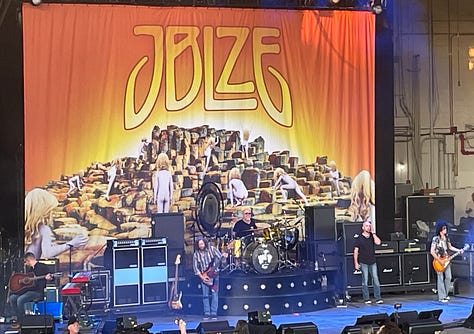

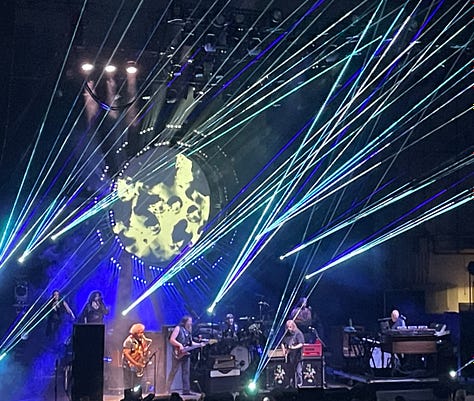
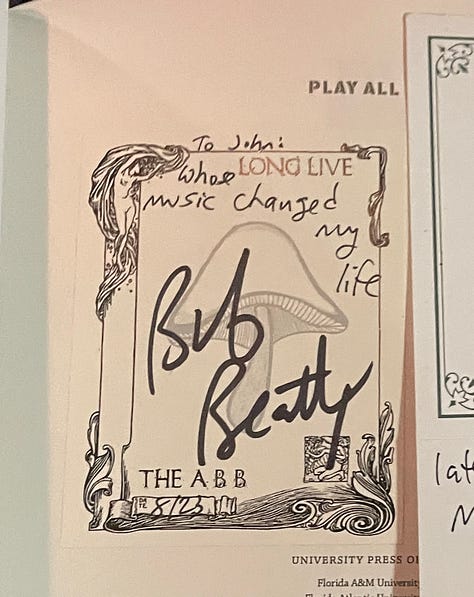
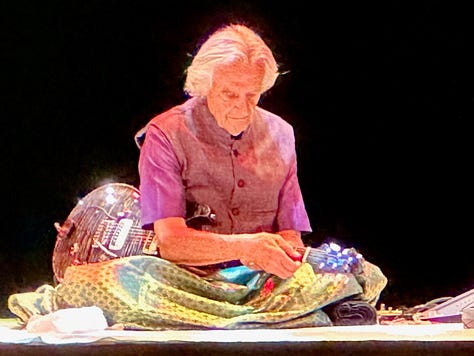
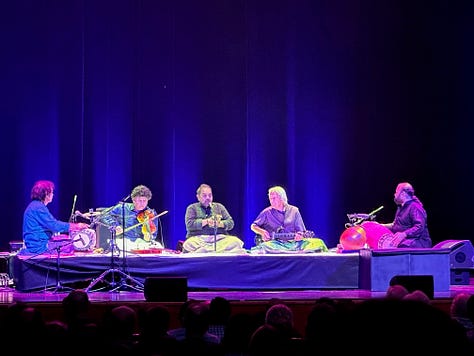
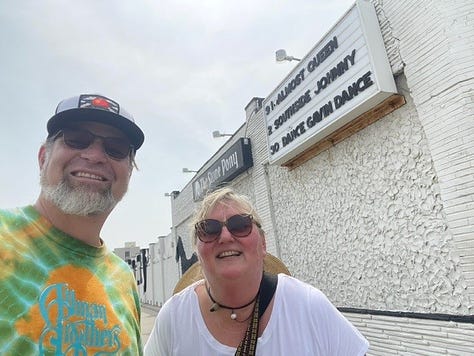

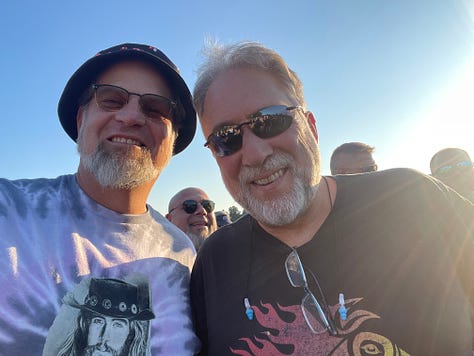
Warren Haynes always delivers.
And Jason Bonham’s band brought the goods. Tribute acts like End of the Line are a lot of fun. They’re bands playing the music of our heroes out of love and respect. There were times when I closed my eyes during EACH set and truly could not have told the difference between what I was hearing and what my soul is attuned to. The visual can sometimes be disorienting, but the audio sounded just fine to me.17
The Allman Brothers Band, Led Zeppelin, Pink Floyd, Shakti, and Springsteen in four consecutive days. I’d say that’s a helluva run.18
Thanks for reading, y’all. Please tell others.
If you liked this post, please share it with at least one person.
Guilty as charged.
I remember how shocked I was the ABB played the same set each night of their November 1993 run through Florida, particularly after having seen the Dead (their closest corollary in my mind’s eye) play two entirely different shows back-to-back a few years earlier.
This scene from the Blues Brothers always comes to mind.
Here’s that link again in case you missed it. 9/16/71 Warehouse. No, I’m serious.
Yes, I know this isn’t 1971, but the setlist is nearly identical except for “Leave My Blues at Home.”
“One Way Out” joined the set after March.
Here are my two favorite live versions:
They weren’t supposed to even have that much time.
Listen closely to the intro here. At least 5 people yell out “Whipping Post” before the band starts playing. "Whipping Post" At Fillmore East
The ABB kept this single-set tradition until the 1990s when they began rotating 2 or three standard sets a year. The band only expanded its setlists after 2001 when Warren Haynes rejoined the band in the wake of Dickey Betts’s departure.
“Don’t Keep Me Wonderin’” is on the first Duane Anthology.
I’ve pretty much made my peace with its absence 🍄 but damn it’s frustrating no one thought to lay it down, even just for shits and giggles.
This is my time machine show.
I think the “Dreams” studio cut is among his finest solos.
“You’re welcome,” the Tour Mystic once responded to me when I made that comment.
Many years ago, I caught the Back Doors, a Doors tribute act that was a big deal in the 80s and 90s. They kept the singer’s face in the dark the whole show. Afterwards I saw why, He looked nothing like Jim Morrison.
Thanks to my dude Lach for the EotL tix. My brother, the Chairman, Gary Wonwayout, for hosting me in NJ. And Michelle for the killer tour of Asbury Park.




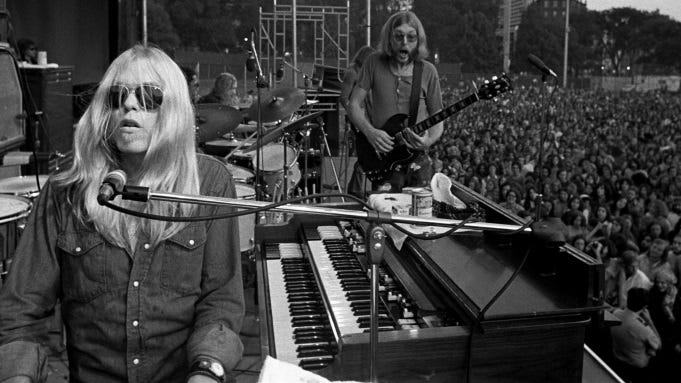


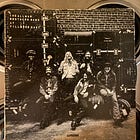

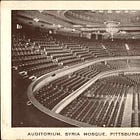
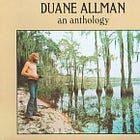
In 1972 the sets became decidedly longer. On April 14th the band played the Academy of Music on 14th St in NY. They headlined an early and late show. I was at the 11:30 show…it began after 1pm. The Allmans didn’t go on until after 3am. We walk out into the morning light…about 7:30. An insane night of music, without Duane. But Berry was there for Whipping Post and Mountain Jam. I vividly remember his coming in from stage right for the bass solo following the drums. This show was LONG! At least 2 and a half hours….after 2 opening acts. The NY Rock Ensemble and ??? Can’t remember I probably slept through them!!
I was at the Warehouse 9/16/71 show & it is still the greatest concert I've ever been to & I've seen all the greats. The loud whistle between songs is me.